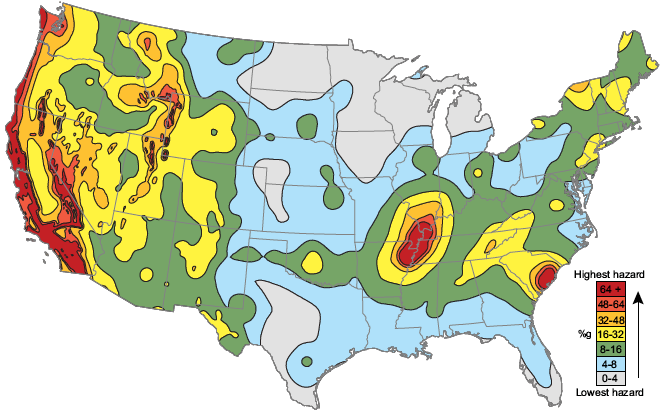

USGS scientists also continue to work with user communities throughout the nation to ensure that USGS earthquake hazard information and products are readily available, easily understood and appropriately used for earthquake mitigation and response planning. The Landers earthquake, which had a moment magnitude (Mw) of 7.3, was the largest earthquake to strike the contiguous United States in 40 years. The USGS conducts research necessary to monitor earthquakes, characterize and identify earthquake hazards, assess earthquake risks and maintain suitable seismic hazard maps in support of building codes. If you find the information useful and would like to support our team in integrating further features, write great content, and in upgrading our soft- and hardware. Similarly, the amplification of ground shaking due to different soil types was not considered, which could lead to a further increase in the number of people exposed to stronger shaking. We're aiming to achieve uninterrupted service wherever an earthquake or volcano eruption unfolds, and your donations can make it happen Every donation will be highly appreciated. USGS scientists are currently researching ways to understand potential ground shaking from induced earthquakes and incorporate that knowledge in U.S.

The USGS is dedicated to continuously updating research on population and infrastructure exposure as communities change and new science is available on earthquake behavior.”Įarthquakes due to human activity-or induced seismicity-were not accounted for in these estimations. “Of particular concern is the significant amount of critical infrastructure located in high earthquake-hazard areas, ranging from private and public schools to health care facilities and fire stations. “This new research helps us better understand the scale of earthquake hazards and ultimately strengthen the nation’s ability to protect Americans against future events,” said Kishor Jaiswal, a USGS research structural engineer as well as the lead author of the study. USGS table showing state population levels exposed to potential earthquake ground shaking.

This time frame is thought to be reasonable for life-safety considerations when designing buildings and other structures. The USGS shaking calculations consider the chance of an earthquake occurring in a 50-year time frame, as that is the typical lifetime of a building. Approximately 57 million people are in areas with a moderate chance of such shaking, and 28 million people in areas that have a high potential to experience damaging shaking. “Populations have grown significantly in areas prone to earthquakes, and USGS scientists have improved data and methodologies that allow for more accurate estimates of earthquake hazards and ground shaking.”Ībout 143 million people live and work in areas with some potential for damaging shaking, a level that could at least lead to damage in structures. “The new exposure estimate is nearly double the previous 2006 estimate of 75 million Americans in 39 states, and is attributed to both population growth and advances in science,” said William Leith, who is the USGS senior science advisor for earthquake and geologic hazards and a co-author of this study. Scientists with the USGS published this research online today in the journal Earthquake Spectra. territories are added, this number rises to nearly half of all Americans. When the people living in the earthquake-prone areas of Alaska, Hawaii and U.S. Both tremors were the biggest earthquakes to hit Southern California in almost two decades.More than 143 million Americans living in the 48 contiguous states are exposed to potentially damaging ground shaking from earthquakes. A precursor 6.4 magnitude quake first struck the desert community the morning of July 4. The military base is 150 miles north of Los Angeles and just northeast of Ridgecrest. The epicenter of the 7.1 magnitude earthquake that hit Ridgecrest on the evening of July 5 and rattled the nerves of millions of Southern Californians - from Los Angeles to Orange County and beyond - was within the Naval Air Weapons Station China Lake. His student, geology major Salena Padilla, an intern at the Southern California Earthquake Center, joined him in the field. A native of quake-prone Turkey, he has spent years studying California’s famed San Andreas Fault.Īkçiz packed his bags and geology tools, and left for the desert on July 6 as one of several earthquake experts called to the scene to assess the aftermath of the intense seismic shaking. “We’re trying to map the delicate rupture trace and measure the surface offsets before they quickly deteriorate and disappear,” shares Akçiz, assistant professor of geological sciences.


 0 kommentar(er)
0 kommentar(er)
